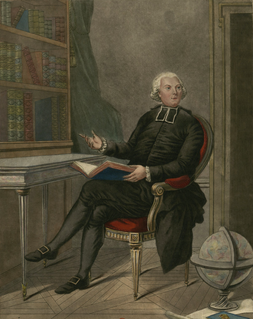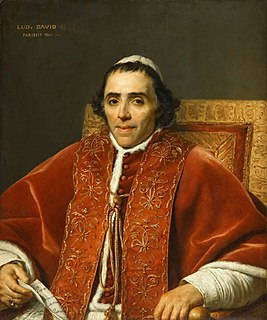
Pope Pius VI was head of the Catholic Church and ruler of the Papal States from 15 February 1775 to his death in 1799.

Pope Pius VII, was head of the Catholic Church and ruler of the Papal States from 14 March 1800 to his death in 1823. Chiaramonti was also a monk of the Order of Saint Benedict in addition to being a well-known theologian and bishop.

Johann Joseph Ignaz von Döllinger, also Doellinger in English, was a German theologian, Catholic priest and church historian who rejected the dogma of papal infallibility. Among his writings which proved controversial, his criticism of the papacy antagonized ultramontanes, yet his reverence for tradition annoyed the liberals.

Jean-Sifrein Maury was a French cardinal, archbishop of Paris, and former bishop of Montefiascone.

Pietro Gasparri, GCTE was a Roman Catholic cardinal, diplomat and politician in the Roman Curia and the signatory of the Lateran Pacts. He served also as Cardinal Secretary of State under Popes Benedict XV and Pope Pius XI.

Ercole Consalvi was a deacon and cardinal of the Catholic Church, who served twice as Cardinal Secretary of State for the Papal States and who played a crucial role in the post-Napoleonic reassertion of the legitimist principle of the divine right of kings, of which he was a constant supporter.
In pectore is a term used in the Catholic Church for an action, decision, or document which is meant to be kept secret. It is most often used when there is a papal appointment to the College of Cardinals without a public announcement of the name of that cardinal. The pope reserves that name to himself. The Italian language version of the phrase – in petto – is sometimes used. When the name of a new cardinal is announced or made public, it is sometimes said to be published.

The 1799–1800 papal conclave followed the death of Pope Pius VI on August 29, 1799, and led to the selection of Cardinal Barnaba Niccolò Maria Luigi Chiaramonti, who took the name Pius VII, on March 14, 1800. This conclave was held in Venice and was the last to take place outside Rome. This period was marked by uncertainty for the Pope and the Roman Catholic Church following the invasion of the Papal States and abduction of Pius VI under the French Directory.

Sant'Anastasia is a minor basilica and titular church for cardinal-priests in Rome, Italy owned by the Syro-Malabar Catholic Church.

Ignaz Heinrich Karl von Wessenberg was a German writer and scholar, and liberal Catholic churchman as well as Vicar general and administrator of the Diocese of Constance. Imbued from his early youth with Josephinistic and Febronian principles, he advocated a German National Church, somewhat loosely connected with Rome, supported by the State and protected by it against papal interference. He encouraged the use of the vernacular in liturgical texts, the hymn book and the regular Sunday sermon.

Giuseppe (Andrea) Albani was an Italian Roman Catholic Cardinal. He played an important role in the elections of Leo XII, Pius VIII and Gregory XVI.

Rudolph Johann Joseph Rainier, Archduke of Austria, Prince Royal of Hungary and Bohemia, Cardinal-Archbishop of Olomouc, was a member of the House of Habsburg-Lorraine, and an Austrian clergyman and noble. He was consecrated as Archbishop of Olomouc (Olmütz) in 1819 and became cardinal in the same year. Rudolph is known for his patronage of the arts, most notably as sponsor of Ludwig van Beethoven, who dedicated several of his works to him.

A crown-cardinal was a cardinal protector of a Roman Catholic nation, nominated or funded by a Catholic monarch to serve as their representative within the College of Cardinals and, on occasion, to exercise the right claimed by some monarchs to veto a candidate for election to the papacy. More generally, the term may refer to any cardinal significant as a secular statesman or elevated at the request of a monarch.

The Apostolic Nunciature to Germany is an ecclesiastical office of the Roman Catholic Church in Germany. It is a diplomatic post of the Holy See, whose representative is called the Apostolic Nuncio to Germany with the rank of an ambassador. The office of the nunciature has been located in Berlin since 1925, in union with the new Apostolic Nuncio to Prussia until 1934. Between 1920 and 1925 the nunciature was held in personal union by the Apostolic Nuncio to Bavaria, seated in Munich. With the unconditional surrender of Germany in 1945 the diplomatic ties were interrupted and reestablished for West Germany only in 1951, then in Bonn. In 2001 the nunciature moved again to Berlin.

The Prince-Bishopric of Augsburg was one of the prince-bishoprics of the Holy Roman Empire, and belonged to the Swabian Circle. It should not be confused with the larger diocese of Augsburg, over which the prince-bishop exercised only spiritual authority.
The Congress of Ems was a meeting set up by the four prince-archbishops of the Holy Roman Empire, and held in August 1786 at Bad Ems in the Electorate of Trier. Its object was to protest against papal interference in the exercise of episcopal powers, and to fix the future relations between the participating archbishops and the pope. Representatives of the three elector-archbishops: Friedrich Karl von Erthal of Mainz, Maximilian Franz of Cologne, Clemens Wenceslaus of Trier, as well as of Prince-Archbishop Hieronymus von Colloredo of Salzburg took part.

Franziskus von Paula Herzan von Harras or František de Paula Hrzán z Harasova was a Roman Catholic cardinal from what is now the Czech Republic.

Michele Viale-Prelà was an aristocratic Catholic priest from Corsica, France, who served as a diplomat for the Holy See in Switzerland, Bavaria and Austria. He became a Cardinal and the Archbishop of Bologna. When Bologna, formerly one of the Papal States, was incorporated into the Kingdom of Sardinia, he refused to recognize the new rulers.
The Concordat of 24 October 1817 was a concordat signed on 24 October 1817 between the Kingdom of Bavaria and the Holy See.

Angelo Bianchi was an Italian prelate of the Catholic Church who worked in the diplomatic service of the Holy See and worked in the Roman Curia. He became a cardinal in 1889.

















